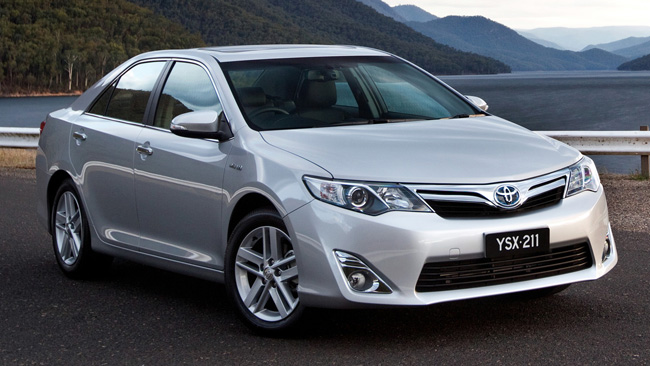The Commodore SS is so good it's headed to the USA to become a hotrod Chevrolet and will spearhead the heartland brand's NASCAR racing drive in 2013 and beyond.
The Ford Falcon with EcoBoost motivation sets a new standard for big cars with baby engines and the Territory is selling strongly since it got an overdue diesel engine for motivation.
The Toyota Camry and Aurion prove that Australian factories can still build world-class quality, with tasty local tweaking for our roads and drivers. So, what's gone wrong for the Australian carmakers, who are winding back and cutting jobs almost across the board?
The simple answer is that we're spoiled. And spoiled rotten. More than 50 brands are plugging their stuff in Australia today and that means the choice and value has never been better. When you add the impact of the healthy Australian dollar, which makes cheap cars from Thailand and Korean even more affordable, the imports get an unbeatable head start over the locals.
The only exception is the Holden Cruze, but we'll get to that later. So, why would you buy a Falcon or Commodore for family use when you can get a flexible SUV with more equipment for the same money, or even less?
And it's a sad fact that the big, traditional Aussie cars are unfashionable on the school runs that are now dominated by the SUVs like the Nissan Dualis, Kia Sportage, Toyota LandCruiser and - at schools for toffs - BMW X5s and Benz MLs. The only possible exception is the muscular Holden Sportwagon, and we'll also get to that later.
The real problem is with the meat-and-veggies cars that have been Australian staples for around 50 years, but don't provide the same taste or satisfaction today. Imagine trying to compete with Asian fusion cooking or the latest tasty Tapas using fifties-style burnt roast beef and baked spuds.
In many ways, the three surviving local makers - Nissan folded in the eighties and Mitsubishi shut down in 2008 - are victims of their own long-term success and poor planning. They didn't need to change for the longest time, especially when Holden was exporting the Commodore to America as a Pontiac and Toyota was banking big bucks from its Middle East sales, and now they have been overtaken by rapid changes in showrooms.
Every month there are more people moving to SUVs and small cars, which the locals - apart from the Cruze - don't make. And there is zero chance of Toyota switching to the Corolla or Ford Australia making a case to bring the Focus to Broadmeadows - even though it was once part of the forward program at the same time as Holden was committing to the Cruze - because small cars mean small profits, but the start-up costs would be more than $500 million.
Ford and Holden say they are committed to the Falcon and Commodore until the end of 2016, and Holden has a much longer timeline thanks to the profits and flexibility it gets from the four-cylinder Cruze. But the VF coming next year and the updated Falcon in 2014 will be the last truly Australian cars.
After that, if they still need a big car in a downsizing world, Ford and Holden will be looking to the USA and imports. That means big problems for the companies that Toyota chief John Conomos once said were locked into the 'rust belt' with Ford or Holden traditionalists from the fifties and sixties.
These days, the younger generations who grew up with Toyota Corollas and then Hyundai Excels don't even consider a Falcon or Commodore, despite the incredible value of such big and comfortable cars with sub-$40,000 starting prices. By world standards, those prices are outstanding and the cars are way better than the everyday Chevrolets and Fords in the USA, but they rumble under the radar.
Sales of big cars have been sliding for more than a decade and the Falcon is the most obvious victim. The company is winding production back to just 148 cars a day - and half of those are Territory. Holden is also being hit much harder now and, after losing its title as Australia's favourite car to the Mazda3 in December the Commodore could only manage eighth in June, its worst place since it hit the road in 1978.
The Camry and Aurion are doing a little better, helped by a model change this year, the strength of Toyota's sales network, and the proven drawing power of a four-cylinder engine and the latest hybrid. All three local carmakers now rely on massive government subsidies and handouts - Ford much prefers to call it 'co-investment' - to keep them in business.
The $100 million-plus update for the Falcon in 2014 would not have been possible without cash from Canberra, while Holden's recent profit of $90 million is - in a bizarre coincidence - almost exactly the same as its latest government support package.
Both brands are now banking the expertise of their designers and engineers, who undertake a range of global projects from their bases in Fishermans Bend and Broadmeadows, but it's not nearly enough to give them a long-term future as local manufacturers.
Holden has made a just-in-time jump from the Commodore to the Cruze, and Toyota in Japan is committed to an Australian car making outpost, but it's only a question of time before Ford is faced with the hard-line decision to close. At the time Mitsubishi decided to shut its factory in Adelaide its family-focussed 380 sedan was easily the best car it had developed or built in Australia. It was dowdy but did the job, as resale values now prove.
It's looking like the same story for the Falcon, which is better today than ever before - and surprisingly frugal as an EcoBoost four - but not new or trendy or flashy enough for car buyers who have been won by the newer, tastier treats arriving almost every day from somewhere else in the world.
FORD TERRITORY DIESEL
The Territory with the diesel isn't just a good car, it's great. It has real performance, flexibility, towing power and the price is nice. But - and it's a giant elephant in the room - the updated engine arrived at least four years too late. A diesel Territory was approved way back when the late Geoff Polites was running Ford Australia - after bulldozing the Territory past the bean counters in Detroit - but the decision was reversed and then reversed again for the final go.
Broadmeadows also failed dismally to respond to quality glitches and suspension dramas, tainting a hero it should have been boosting. Right now, half of the cars coming off the production line at Ford Australia are Territorys and that percentage is likely to rise as more people hook up with the bolder new look and quality boost, as well as banking the advantage of the diesel under the bonnet.
 Ford Territory - compare this car
Ford Territory - compare this car
Price: from $48,240
Engine: 6 Cylinder, 2.7-litre turbodiesel, 140kW/440Nm
Transmission: Sports Automatic, Four Wheel Drive
Thirst: 8.8 / 100Km

HOLDEN COMMODORE SS SPORTWAGON
Why would you buy a European car when you can get this much punch and panache for less than $50,000? When Holden changed gears on the Commodore wagon, taking it from a basic long-wheelbase hauler into a flexible family escape machine, it knew the Sportwagon was a gamble.
But it's worked well and the proof is the number of buyers who go for a V8 in the nose and SS or Calais trimming. They are happy to pay for the bells-and-whistles because the car looks good and kicks. It's almost impossible to pick the Sportwagon from the Commodore sedan in any sort of driving, even with a full fun factor, and the tail end gives BMW-style flexibility for young families or singles with weekend hobbies. Sportwagon-style smart thinking is what is going to keep Holden going as a local maker, provided it can zero-in on a workable package for the Commodore beyond 2016.
 Holden Commodore SS Sportwagon
Holden Commodore SS Sportwagon
Price: from $49,790
Engine: 6.0 Litre 8 Cylinder
Transmission: 6-speed, manual rear wheel drive
Thirst: 12.2l/100Km

TOYOTA CAMRY HYBRID
The new greenie from Brand T is actually a closet performance car. It can run electric in stop-start city traffic for a maximum eco boost, but gets a battery belt when you want to go. It's one of the coming generation of hybrid cars - think BMW, think Mercedes, think Subaru - which will use extra boost from batteries to provide honest performance with only a small-capacity combustion engine.
The new Hybrid is also part of a Camry family that's been totally changed for 2012, with new looks, more comfort and better value. Best of all, the Aussie Camry is tweaked and tizzied a home for local owners and roads - even though it's still a solid earner with exports to the Middle East.
 Toyota Camry Hybrid - compare this car
Toyota Camry Hybrid - compare this car
Price: from $34,990
Engine: 2.5-litre, 4-cyl petrol, 118kW/213Nm
Transmission: CVT, front-wheel drive
Thirst: 5.2L/100km, 121g/km CO2






 Holden Commodore SS Sportwagon
Holden Commodore SS Sportwagon 










Comments